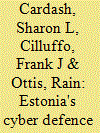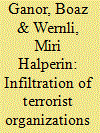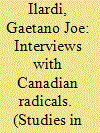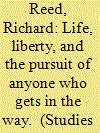|
|
|
Sort Order |
|
|
|
Items / Page
|
|
|
|
|
|
|
| Srl | Item |
| 1 |
ID:
123348


|
|
|
|
|
| Publication |
2013.
|
| Summary/Abstract |
The cyber threat spectrum that prevails today is both broad and deep. While we cannot protect everything, everywhere, all the time, we can and must make a concerted and sustained effort to shore up national defenses as they pertain to cybersecurity. Despite considerable differences of scale and scope, Estonia's made-in-country cyber solutions may hold promise for the United States, at least with some adjustments and tailoring to take into account differing requirements and traditions. There may be much to learn from a country that bills itself as "e-Estonia, the digital society," and also delivers on that promise. Specifically, the country's Cyber Defence League is a concept and construct that may prove useful for the United States to consider and contemplate at a time when significant cyber threats continue to multiply, but the skilled personnel needed to counter the challenge are in short supply on the U.S. side.
|
|
|
|
|
|
|
|
|
|
|
|
|
|
|
|
| 2 |
ID:
123345


|
|
|
|
|
| Publication |
2013.
|
| Summary/Abstract |
After 2003, Australia's domestic jihadist plots shifted from being externally guided to being entirely self-starting, which was out of sync with international trends. To identify the causes behind this turning point, this article first provides a brief overview of jihadist activity in Australia, showing how the post-2003 shift differentiates it from comparable countries. The article then examines several potential explanations for the shift that prove insufficient. Following that, the article demonstrates that the shift occurred because key facilitators between Australia and South Asia were removed or deterred. This factor, combined with the limited strategic importance of Australia, low levels of jihadist radicalization, and limited diaspora involvement from the countries most central to Al Qaeda operations, explains Australia's specific pattern of jihadist activity.
|
|
|
|
|
|
|
|
|
|
|
|
|
|
|
|
| 3 |
ID:
123343


|
|
|
|
|
| Publication |
2013.
|
| Summary/Abstract |
Criminal syndicates and terrorist organizations are inherently different, one motivated by profit and the other by political goals. Yet their difference enables them to cooperate for their mutual benefit. Nowhere has this been more evident than in the drug trade; from harvesting and trafficking in illegal substances, it has been an easy transition to counterfeiting and disseminating medications. Hezbollah, in particular, has become involved in the production, smuggling and distribution of counterfeit medications in North America, Africa and the Middle East as a means of raising immense sums of money to finance its terrorist activities. Hezbollah's infiltration into the pharmaceuticals industry illustrates the danger posed by the marriage of terrorism and crime, which arises both from enhanced resources for terrorism, and from the corruption of a legitimate and necessary industry. Understanding the nature and extent of this danger is the first step in preparing to meet it.
|
|
|
|
|
|
|
|
|
|
|
|
|
|
|
|
| 4 |
ID:
123344


|
|
|
|
|
| Publication |
2013.
|
| Summary/Abstract |
Based on in-depth interviews with seven Canadian radicals in 2011, this article provides a detailed and nuanced insight into these men's personal journeys into, and in some cases, exit from, the world of radical Islam. Reflecting on their motivation, emotions, and decision-making processes, these men's stories demonstrate that the radicalization experience is anything but straightforward in the sense of there being a single and unambiguous motivation that spurs individuals on. Rather, they reveal that they were drawn to, and remained involved with, the world of extremism for a variety of reasons, not all of which necessarily related to the existence of grievances, real or imagined. Moreover, the relative importance of these drivers appeared to be in a state of flux, depending on an individual's needs or circumstances at any given time. Indeed, the highly idiosyncratic and temporally specific nature of the radicalization process, as demonstrated by these men's accounts, does not bode well for government and law enforcement efforts to anticipate specific cases of radicalization.
|
|
|
|
|
|
|
|
|
|
|
|
|
|
|
|
| 5 |
ID:
123346


|
|
|
|
|
| Publication |
2013.
|
| Summary/Abstract |
This article presents a comparative analysis of the militia movement in the United States and the two major loyalist paramilitary organizations in Northern Ireland. The comparison reveals a similar history of economic transition that highlights the need to consider occupational factors in assessing the causes of violent extremism. The article reflects further on the evidence of a number of other similarities between the two groups: the preeminence of historical narratives, the tendency toward militancy and violence, and localist, antigovernment ideologies. It is argued that these similarities can be similarly understood within the same economic framework, and suggests further research in similarly comparative contexts would reveal greater insight.
|
|
|
|
|
|
|
|
|
|
|
|
|
|
|
|
|
|
|
|
|